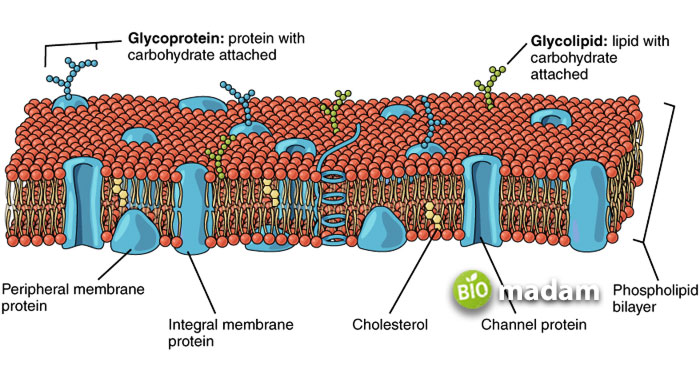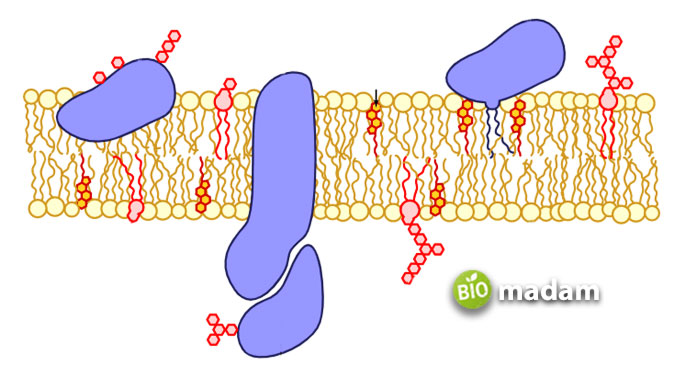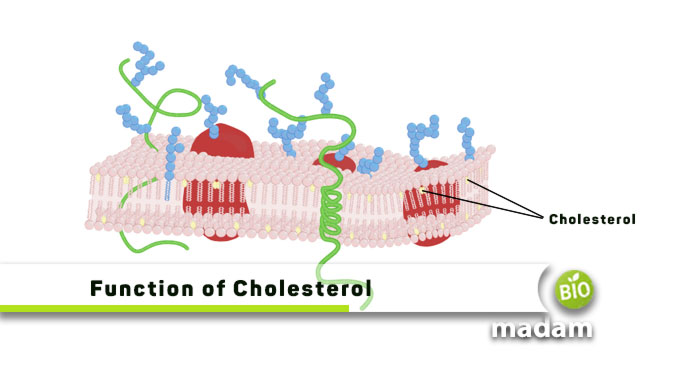The cell membrane is a complicated component of the eukaryotic and prokaryotic cells. It comprises different components, such as carbohydrate molecules, lipids, and different types of proteins. Microscopic analysis of the cell membrane has shown the presence of glycolipids, phospholipids, and cholesterol within the structure. Maintaining stability is the main function of cholesterol in the cell membrane. Let’s find out more about the role and structure of cholesterol.
What is Cholesterol?
Cholesterol is a sterol compound found in body tissues and organs. It is a waxy substance required to produce vitamin D, cell membranes, and hormones secreted by various glands in the body. Your body either gets the required cholesterol from food sources or produces it in the liver for bodily processes. Cholesterol and other derivatives are present in the cell membrane besides being dispersed in blood. A high amount of bad cholesterol or LDL in the blood can lead to coronary artery disease.
Cholesterol in Cell Membrane
Cholesterol comprises up to 30% of the plasma membrane lipids in different types of eukaryotic cells. An adequate amount of cholesterol in the cell membrane is essential for regulating particular cellular processes like maintaining integrity and mechanical stability. However, plant cell membranes do not have cholesterol, as the cell wall, instead of the cell membrane, contributes to mechanical support.
Cholesterol is similar to phospholipids and contains a hydrophilic and hydrophobic end. The OH– group acts as the hydrophilic part aligning towards the phosphate heads. On the other hand, the hydrocarbon tail and steroid ring give the hydrophobic characteristic.

Function of Cholesterol in Cell Membrane
Cholesterol plays a critical role in providing mechanical support to the bilayer structure of the cell membrane. It regulates the thickness, fluidity, compressibility, and water penetration of the plasma membrane in organisms without a cell wall. Here are the functions of cholesterol in detail:
Membrane Fluidity and Stability
The cholesterol embedded in the phospholipid bilayer changes the fluidity of the membrane depending on the temperature. The fatty acids in the membrane may freeze or melt in case of temperature deviation, leading to changes in the membrane fluidity. The phospholipids in the membrane move away from each other at high temperatures, and the distance significantly decreases at low temperatures. Cholesterol maintains the membrane’s stability by ensuring that these molecules do not deviate from their position. Thus, it ensures that the movement of substances through active or passive transport occurs properly.
Molecule Specificity
The cholesterol in the cell membrane contributes to the structure to ensure that only specific molecules pass through. It makes sure that the very small water-soluble molecules which must not pass the membrane stay on the other side. They might otherwise move inside and out of the cell very easily.
Regulation of Vesicular Trafficking
Cholesterol fits most of its structure into the cell membrane with the steroid rings attracted towards hydrocarbon chains of neighboring lipids. The attraction between these molecules and compounds produces a condensing effect and gives rise to cholesterol-rich regions called membrane rafts. Membrane rafts also contain proteins besides cholesterol and signal various cellular processes. Researchers studied membrane rafts through microscopy techniques using specific agents to understand their role in cell secretion and vesicular trafficking. Cholesterol has been seen to play a critical role in vesicle secretion, which is necessary for vesicular trafficking.
Protection of Membrane Lipids against Chemical Damage
While the role of cholesterol is well-known in maintaining membrane structure and changing fluidity per need, a lesser-known function of the cell membrane is the protection from chemical damage at the air-water interface.
Adding 30 mol % cholesterol to 1-palmitoyl-2-oleoyl-sn-glycero-3-phospho-(1′-rac-glycerol) (POPG) or 1,2-dipalmitoyl-sn-glycero-3-phosphocholine (DPPC) reduces ester linkage cleavage and oxidation induced by HCl and OH radicals. It exhibits the chemoprotective function of cholesterol in avoiding oxidation that may damage the cholesterol in a lipid membrane. Restricting the chemical damage to unsaturated lipids also prevents the generation of Criegee intermediate involved in other atmospheric processes.

The Bottom Line
The cell membrane or plasma membrane contains various lipid compounds, including cholesterol. Cholesterol helps maintain the structure of the cell wall by regulating fluidity. It also controls the entrance and exit of molecules across the cell membrane that may otherwise float freely. One of the main functions of cholesterol in cell membranes is the regulation of vascular trafficking. The presence of cholesterol also protects membrane lipids against chemical damage.
FAQs
What is the function of cholesterol transport?
Cholesterol regulates transport by restricting the movement of certain molecules and allowing a few others to pass. Catabolism of cholesterol by enzymes in the endoplasmic reticulum and mitochondria generates oxysterols, steroids, and bile acids.
What are properties of cholesterol?
Cholesterol has a waxy consistency and belongs to the family of steroids. It is white, odorless, and tasteless, with a crystalline structure. The chemical formula for cholesterol is C27H46O.
Is cholesterol a transport protein?
Cholesterol is not a protein but a lipid. Sterol transfer proteins, or STPs, transport cholesterol through nonvesicular mechanisms across the cell membrane.
What is cholesterol made of?
Cholesterol is a lipid compound comprising a central sterol nucleus with a hydroxyl group and four hydrocarbon rings. It also has a hydrocarbon tail. The central nucleus is present in all steroid hormones.
Which cells digest cholesterol?
Macrophages, the engulfing cells, play a role in the digestion of cholesterol derived from extracellular lipoproteins; these macrophages convert to foam cells.
What proteins carry cholesterol?
Lipoproteins are involved in the transport of cholesterol, including LDL cholesterol and HDL cholesterol. LDL, or low-density lipoprotein cholesterol is the bad cholesterol; a high amount of LDL can lead to coronary artery disease.
What causes high cholesterol?
As your body receives cholesterol from fatty foods, a high intake of foods rich in fats and oils can lead to a high cholesterol concentration in the body. Being overweight and having a sedentary lifestyle may also lead to cholesterol and bad fat accumulation.

Anna has completed her degree in Pharmacy from the University of Hawaii. She is serving as a research assistant in a pharmaceutical company. She had a great interest in writing blogs, traveling to different parts of the US, and trying delicious recipes in her spare time.

